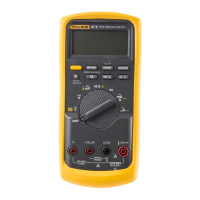Multimeters
Making Measurements
13
Power-Up Options
Holding a button down while turning the Meter on activates
a power-up option. Table 4 includes the power-up options.
Automatic Power-Off
The Meter automatically turns off if you do not turn the
rotary switch or press a button for 30 minutes. If MIN MAX
Recording is enabled, the Meter will not power off. To
disable automatic power-off, refer to Table 4.
Input Alert
™
Feature
If a test lead is plugged into the mA/μA or A terminal, but
the rotary switch is not set to the correct current position,
the beeper warns you by making a chirping sound and the
display flashes “LEAd”. This warning is intended to stop
you from attempting to measure voltage, continuity,
resistance, capacitance, or diode values when the leads
are plugged into a current terminal.
W Caution
Placing the probes across (in parallel with) a
powered circuit when a lead is plugged into a
current terminal can damage the circuit you
are testing and blow the Meter's fuse. This
can happen because the resistance through
the Meter's current terminals is very low, so
the Meter acts like a short circuit.
Making Measurements
The following sections describe how to take
measurements with the Meter.
Measuring AC and DC Voltage
Model 87 features true rms readings, which are accurate
for distorted sine waves and other waveforms (with no dc
offset) such as square waves, triangle waves, and
staircase waves.
The Meter's voltage ranges are 600.0 mV, 6.000 V, 60.00
V, 600.0 V, and 1000 V. To select the 600.0 mV dc range,
turn the rotary switch to mV.
To measure ac or dc voltage, refer to Figure 2.

